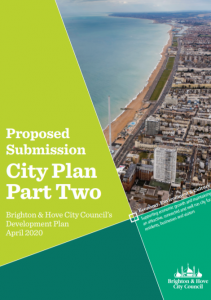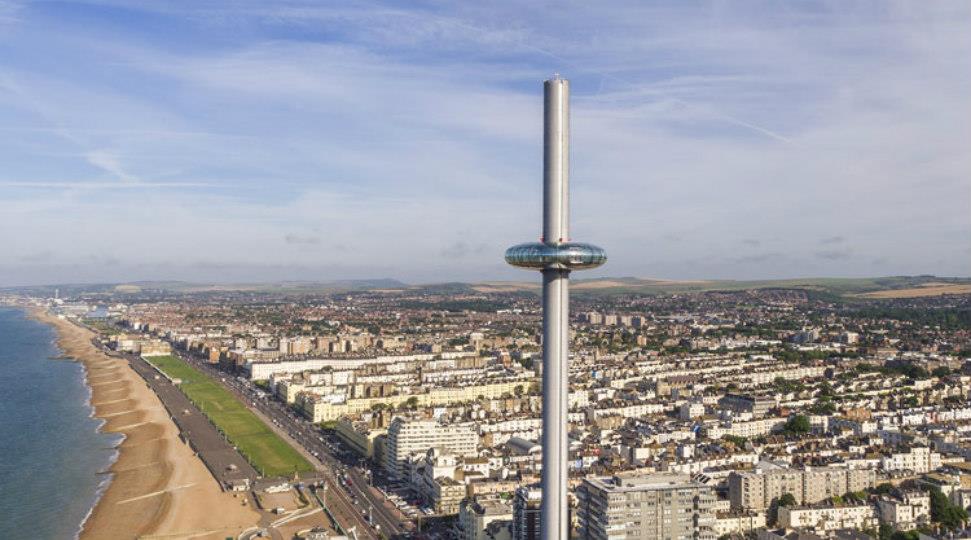A blueprint for the future of Brighton and Hove over the next 10 years has been published by Brighton and Hove City Council.

And councillors will be asked to approve the document – known as City Plan Part Two – at a virtual meeting of the full council in a fortnight’s time. Click here to see it.
The 224-page draft plan sets out where new homes and workplaces can be built as well as council policies on student flats, shared houses and homes for older people.
It contains dozens of “management policies” to help councillors and officials when they decide planning applications.
The policy areas include employment space, design and heritage, transport, the environment and energy.
When the council carried out a 10-week consultation nearly two years ago, 349 people responded and 518 signed a petition.
The document identified more than 50 sites for new homes and three sites for purpose-built student flats but said that two or three-bedroom family homes were the most needed type of housing.
Urban fringe
City Plan Part Two identified 39 sites for housing in built-up areas and 16 on the “urban fringe” – the green outskirts of Brighton and Hove.
The urban fringe sites present councillors with some of the most controversial choices.
They include the “joint venture” sites where the council plans to build hundreds of new homes in partnership with Hyde housing association. The joint venture’s proposals in Coldean and Whitehawk attracted opposition and drew protests.
Last November, Richard Bickers, who chairs the Friends of Whitehawk Hill, called on the council to remove the nature reserve there from its list of potential housing sites.
At the time he said: “It would cut the heart out of the hill’s gorse scrub, a historic landscape feature and habitat which occurs on this part of Whitehawk Hill and not elsewhere, reflecting local differences in soils and forming part of the diversity of the reserve.
“This was barely recognised in the urban fringe assessment. This is used as a breeding habitat by a special group of birds, including Dartford warbler and stonechat, which have bred there in recent years, as well as linnet.”
Land next to the Race Hill on part of the Whitehawk Hill Nature Reserve is still listed for housing but now just 30 homes rather than the initial 200 flats proposed there.
The most responses received during the consultation were objections to two sites in Patcham.
Residents petitioned the council not to allocate land next to Horsdean Recreaction Ground for housing, with people citing the loss of open space, extra traffic and parking pressure.
But the two Patcham sites and land between Ladies Mile Road and Carden Avenue are deemed suitable for 60 homes.
The document proposes a special policy for Benfield Valley which would maintain its open spaces, wildlife and heritage while allowing some building.
The council does not consider the area suitable for largescale development because this would result in the loss of too much open space and change the area’s character.
But landowners and developers want more housing allocated.
The council has allocated two small areas off Hangleton Way for up to 100 homes.
…
Strategic sites
Seven strategic sites are identified in City Plan Part Two including Brighton General Hospital, the Sackville Trading Estate and Coal Yard – and Lyon Close, in Hove.
The plan includes a health hub at the Brighton General site as well as at least 200 homes while retaining the landmark grade II listed former workhouse building.
The council’s Planning Committee has already approved plans by housebuilder Crest Nicholson for 150 flats in four blocks in Lyon Close despite opposition from neighbours.
The committee has also approved plans by another developer, Moda Living, for 800 flats at the Sackville Trading Estate site.
The council wants to modernise the area west of Hove station, with a decision due within months on a scheme to build more than 200 flats in Ellen Street.
In Brighton, Legal and General has planning permission for a build to rent scheme at the Langley Industrial Estate in New England Street.
Smaller sites earmarked for housing include the outpatient building at the Royal Sussex County Hospital, in Eastern Road, the former playground in Swanborough Drive, Whitehawk, and Hove sorting office in Denmark Villas.
…
Ageing population
The blueprint is intended to tackle the challenges of housing an ageing population and the need for more homes for people who are downsizing.
It said: “An important conclusion of the Older People’s Housing Needs Assessment is that there needs to be a wider mix of housing and accommodation options for older people.
“This will include supporting people to live well in their own homes but also requires the provision of a mix of purpose-built housing types and tenures that will facilitate ‘downsizing’/’rightsizing’, creating a climate where moving in later life becomes a realistic and positive choice.”
…
Student housing
Sites are identified for student housing at the Lewes Road bus garage, the former Co-op and Boots site in London Road and a site behind houses in Hollingdean Road.
Work is already under way on the London Road site and councillors approved plans for Hollingdean Road in March.
City Plan Part Two said: “Brighton’s two universities, the University of Brighton and University of Sussex, are major assets that are vital to the city’s economy and make an important contribution to its economic and cultural life and its positive national and international reputation.
“However, the number of permitted PBSA (purpose-built student accommodation) bed spaces, currently assessed to be 12,699, remains below the number of students in the city requiring accommodation, particularly for students at the University of Brighton.”
…
Shared houses
A key policy for many communities will be a planned tightening of the rules on shared houses, also known as houses in multiple occupation (HMOs).
There are about 5,000 shared houses in Brighton and Hove. Some are shared by students and others predominantly by young professionals.
…
Community housing
The blueprint includes support for community-led and self-build housing projects. The council hopes to free up sites on the edge of Brighton and Hove for this type of housing.
…
Shopping areas
City Plan Part Two is intended to protect the niche and independent shops in The Lanes and North Laine as well as local shopping parades in Woodingdean, Hove, Portslade and Hanover.
…
A further public consultation is expected to run online for six weeks from early May – at consultations.brighton-hove.gov.uk.
A virtual meeting of the full council is due to debate the plan. The meeting is scheduled to start at 4.30pm on Thursday 23 April.









I recall this being a twenty-year Plan when it began around 2012! Meanwhile, the King Alfred will perhaps find a place in a 100-Year Plan.
Surely this should be postponed for at least 6 months or until Covid 19 has been eradicated.What is the point in having plans if there is no money to finance them.I would have thought a completely new Transport plan would need to be drawn up.
What is happening with the Hyde Partnership?
I agree. A brave new context after coronavirus may make a mockery of decisions now.
This council should think about the need for residents first, and the elderly who are plagued byrude, dirty, noisey,students who only think about themselfs
they do not contribute anything to the town.
No. It was ment to be sent twice; this council does not listen; it takes several times before you who nake decisions to listen to what is being said
perhaps before building more residences which I agree are required,the current infrastructure to support them throughout the whole of the brighton area and particularly around the train station should be considered.The Brighton gateway scheme which was completed in 2014 is a complete shambles leaving main entry and exit out of Brighton gridlocked.Perhaps the council should consider correcting and making this tenable before embarking on more dwellings which would make the current situation worse.